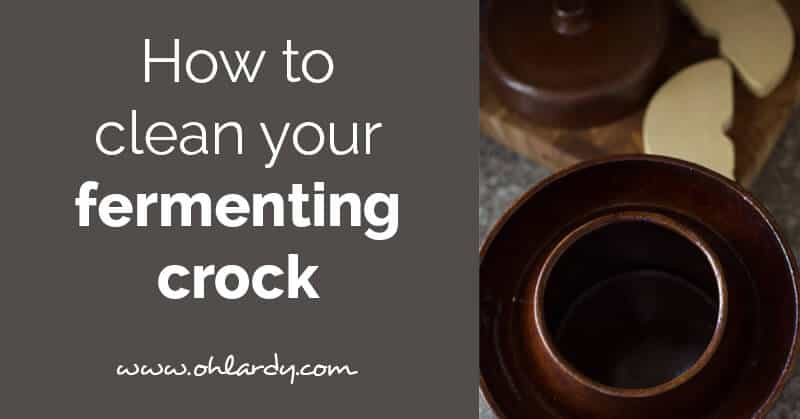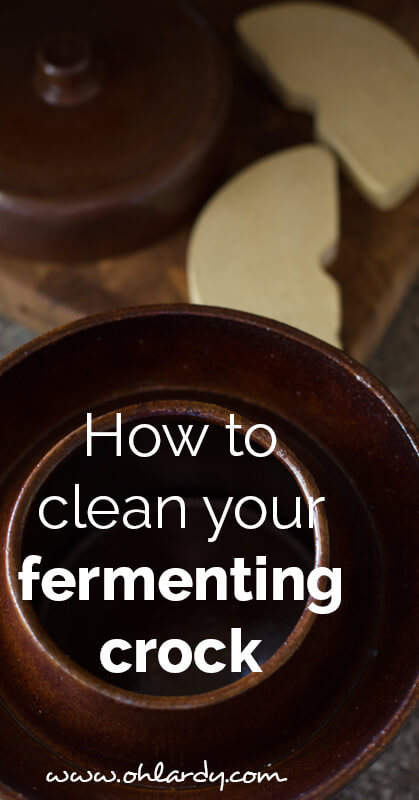How to clean your fermenting crock
Oh Lardy! is a participant in the Amazon Services LLC Associates Program, an affiliate advertising program designed to provide a means for us to earn fees by linking to Amazon.com and affiliated sites.

Lately I have been having a lot of fermenting fails in my fermenting crock. At first, I figured that it was a bad batch of culture starter. I confirmed this after fermenting some carrots in a mason jar that also failed. So, I tossed the box of starter and started with a fresh box. Problem solved!
Nope. Not solved. I started fermenting some pickles with my new packet of starter and those failed as well. It is so sad to lift that lid and look in and find black mold and sad, disgusting pickles. People always ask me, “How will I know if my ferment is bad?” I always respond with, “You will know.” The smell, the mold, the look of everything makes you want to throw the whole crock away with everything in it!
After discovering my batch of pickles failed, I realized that my crock must be contaminated. The crock itself is glazed pottery. Easy to clean – just soap and water and allow it to dry thoroughly. However, the stones are not glazed. They are porous. Soap and water won't cut it if mold spores are living in those stones. I needed to do some heavy duty cleaning of those stones, for sure. I decided to clean the lid as well because the inside of my lid is not glazed, it is porous as well.
How to clean your fermenting crock
The first thing I did was set a gallon of water to boil. I added 1/2 cup of white vinegar to the water. I boiled the lid and the stones for at least 10 minutes. Meanwhile, I heated my oven to 400 degrees. Once the stones and lid had finished boiling, I placed them into the preheated oven, directly on the oven racks. I closed the oven door and turned the oven off. I allowed the stones and lid to cool off with the oven.
I do not store my stones inside the crock. Instead, I invert the lid and place it on top of the crock. Then I set the stones inside the lid. This allows air to circulate over the stones and lid.
I don't clean my crock in this manner after every ferment. I usually just wash with soap and water. However, it would be good practice to do the deep down clean every so often. It is so sad to lose an entire batch of pickles or carrots or sauerkraut.
If you are finding that you aren't having much success with crock, you might want to clean your fermenting crock. It might be just what it needs.


I am a hobbie potter. I am throwing my own crock and making sure to glaze those areas mentioned and to have a totally fused crock to ensure a clean environment.
Can’t wait to get started!
I inherited my parents home and found a 10-, 5-, and 2-gallon crock in the storage area. The 2-gallon crock fulfills all my Sauerkraut needs, but one of these days 10 GALLONS. Braaahahaha!!!
What if I stored my stones inside my crock over the winter. I didn’t know that they could mildew due to moisture. Yes that is what happened. Can I just go through the cleaning steps of boiling and heating stones in the oven to clean them? Can I still use my stones in the crock ? Or do I need to throw them away?
I boiled my lid and stones with white vinegar for 30 mins. They still smell bad, so I can’t keep it in the house.
I was wondering about putting my porous weights in the oven during its cleaning cycle. Has anyone else tried that? Not all ovens are self-cleaning, and I know it gets super hot. I hope those weights can stand up to that kind of heat.
I bake my old crocks to clean them. Starting with a washed crock in a cold oven, turned on lowest setting for an hour. Then up the temp 25 degrees every 40 minutes to 500 degrees. Then start backing down the temp in reverse, try not to peek, keep the door closed and let the oven cool to nearly room temp. The cool air rushing in the oven door will drop the temp enough to crack the crock. Wash again. If the glaze is checked there will be “hair” grown out of the crock, making it look a little freaky. 🙂 To note, you can back the temp off a little faster as it gets toward 200 degrees. You now will be able to ferment without contamination from the crock. I have done this with crocks that are from antique age to newer. Never lost a crock, though one did loose the glaze from an area about the size of a nickle, where I would guess it had been bumped or there was an imperfection. As a disclaimer, please don’t use this on a crock you don’t want to crack or ruin in any way, this is pretty extreme heat for an already fired crock. happy fermenting!
Thank you for the post- it was exactly what I was looking for. I got a new batch of sauerkraut ready to go, then I pulled or my stones and they have mold all over them. Yikes!
I must have missed something. I read the part about cleaning the lid and stones. I didn’t see the part about the actual crock. My mother gave me a crock that belonged to my grandmother. I want to use it.
I recently picked up a #3 Acorn Ware UHL crock. It has been sitting in a damp basement for decades so I soaked and hot water scrubbed it with dish soap and rinsed with boiling water. I noticed a oily sheen floating to the top as I did so, so I added a cup of white vinegar and let set for 30 mins while heating the oven to 400f. I emptied the crock, rinsed and dried it, then placed it in the preheated oven and turned the oven off. I peeked at the crock 1hr later and see this brown greasy ooze coming out of all the crazing both inside and out. Has anyone ever seen this kind of thing and what is it if you have? I wiped it out with paper towels and is very sticky with a foul smell.
Su un coccio nuovo, prima di utilizzarlo, è idoneo, utile e si può “vetrare” (con vetroresina ) sia il fondo coperchio ( se poroso ) che i pesi porosi? Grazie
Same thing happened to me. I had used my crock for several batches of kraut with good results, but the bottom was covered with mold! I did the bake job and also got the black “tar”. I cleaned it off best possible and stored it for the last 9 months. I’m baking it again as I write ta his, I’ll report the results on the second try.
My fermenting crock developed a stink and failed a 10 lb batch of kraut. I baked it at 500 for three hours. It looked like pure evil was trying to escape from all the glazed surfaces. Black tar, foul smelling. I baked it until it was ash. The lid and weights also had the infection. I scrubbed the ash off and tried again. Stinky kraut. Like a septic tank. I think I just have to buy a new crock.
Sorry for not getting back sooner with the results from the second baking of my kraut crock, here’s the result. I did the slow temp up and down as before. No ugliness appeared where it did before or any where else for that matter. I did have a bit of a burnt smell still, but not so much. I did a 12 pound batch of kraut the next day and all went as planned, in fact it was one of the better batches that I’ve done. The crock still had a very slight mold on the bottom when I cleaned it after the ferment, but before the baking I would have to scrape 1/8 inch of gunky mold off of the bottom. I canned the batch as per the Ball Blue Book of canning and it tastes excellent. So maybe Marty’s crock could have used another bake.[?]
I baked it one more time. I turned my oven up to the self-cleaning setting. No more tar, but quite a bit of white ash. After a thorough scrubbing with comet, and then a run through the dishwasher and heated drying, I made a batch. It came out very good, but the weird white lace appeared on the outside of the entire crock within a couple of days of the start of the batch. The sauerkraut is very good. I packed it and stored it in my special fridge for 2 months. just like lagering beer. 50 degrees is perfect for sauerkraut and dark beers.
The white fungus on the outside of the crock has made me lose confidence in it completely. I took great pleasure in smashing it into hundreds of pieces with my favorite ball pein hammer. A new crock is only(?) a hundred dollars. I’ll try a different brand.